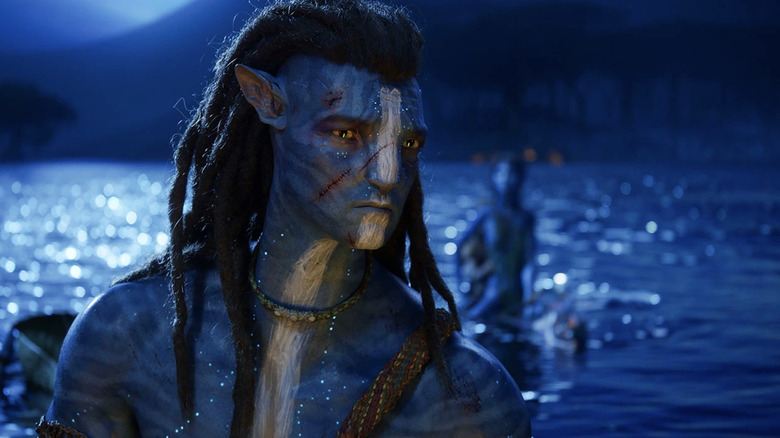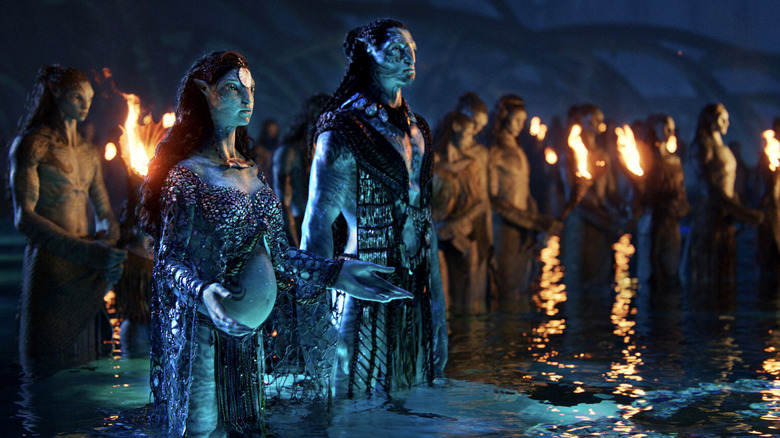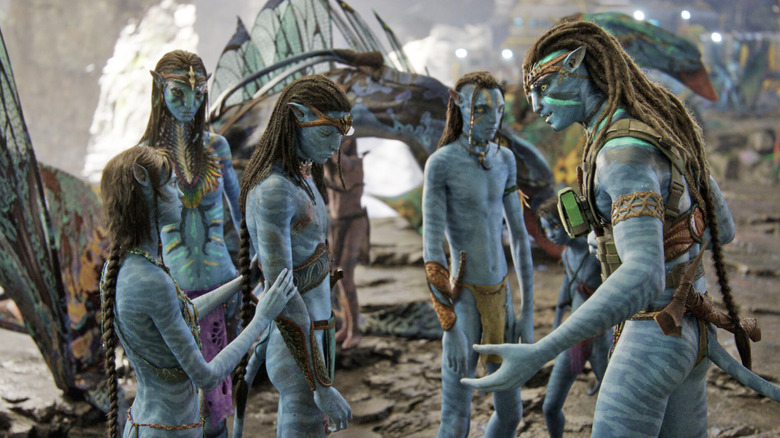Avatar: The Way Of Water And Its Sequels Took So Long Because They Simply Couldn't Have Been Made Earlier
The theatrical landscape has drastically changed in the 13 years since the original "Avatar" was released in theaters to massive financial success. But James Cameron necessarily has spent all that time since the 2009 release still in Pandora, creating his vision for a series of films that spans decades and tells a multi-generational story. Just as Cameron spent years developing new technology, he has also worked hard on the narrative side of things. The story of Jake Sully of the Jarhead clan would grow into something even more extensive than initially planned.
In the vein of massive productions like Peter Jackson's "Lord of the Rings" trilogy and even, to some degree, the Marvel Cinematic Universe, Cameron has carefully crafted an alien world filled with rich details. Pandora is filled with life and an ecosystem that makes the films feel even more real when paired with groundbreaking visual effects. However, none of this worldbuilding came easy, as indicated by the long development time between movies and many delays. According to the visual effects team Wētā FX (formerly known as Weta Digital) who have worked closely with Cameron on the "Avatar" films, this prolonged development period was the only way to make "Avatar: The Way of Water" as groundbreaking as it is.
The ultimate cinematic experience
In an "Avatar: The Way of Water" panel attended by /Film moderated by producer Jon Landau, the Wētā FX team in attendance (Joe Letteri, Richie Baneham, Dan Barrett, Wayne Stables, Pavani Rao Boddapati, Johnathan Nixon) were asked about how they feel about newer blockbusters and the quick turnaround between sequels. Landau was more than ready to back up the long wait between sequels — in fact, he believes they couldn't have made the film otherwise:
"I think that what we're able to present up on the screen today, we couldn't have done five years ago[...] It took this time to create what I believe is currently the ultimate cinematic experience. Why did it take the time? First, Jim took two years to dive [into] the Mariana trench after the last sequels. Then he came back and spent a year writing 1500 pages of story notes."
James Cameron took the scripts for his series of "Avatar" films very seriously. After assembling a writing team to craft the story, Cameron said he threw out the original script for what would become "The Way of Water" because it wasn't up to his standards for an "Avatar" movie. When taking the thorough story process and pairing it with the technological barriers the production team had to crack, it's no wonder there was such a long wait between films. It wasn't just the story process, either. The fact that the production team decided to shoot most of the sequels in one go also led to the 13-year wait.
'We have to raise the bar on what we're doing'
Landau would continue to describe the long process of making the "Avatar" sequels, also explaining that after solid scripts worthy of James Cameron's direction were completed, the decision would also be made to make a fourth "Avatar" film:
"Then we said, 'ok,' we're going to be going out doing, we thought at that time, three sequels and worked with a writing team to break those down into scripts that Jim would want to direct. We decided it needed to be four, and then we said, OK now, let's design four...We shot all of two, three, and the first act of four. That's what took the time."
It's encouraging to see such a large amount of collaboration between Cameron and his team of writers and effects artists. The daunting task of filming so many projects simultaneously didn't seem to deter the team at Wētā, either. Instead, Landau firmly believes that in the 13 years between the first film and "The Way of Water," there was no wasted time. Moreover, the team had the singular goal of elevating the material to the best it could possibly be:
"But all of that time, this team was working. We started talking about this movie since 2013[...] And saying together, 'we have to raise the bar on what we're doing.'"


